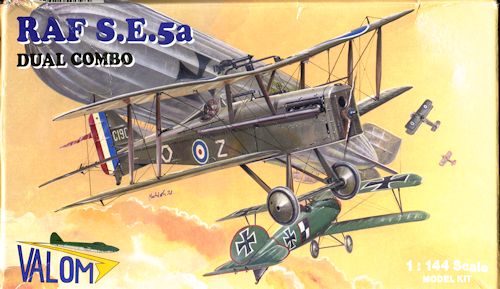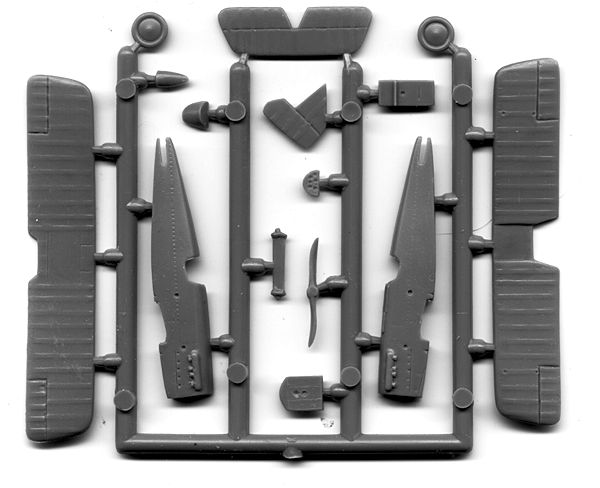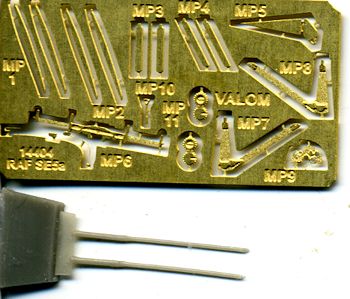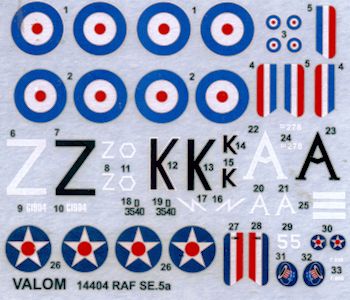
Valom 1/144 SE.5a
| KIT #: | 14404 |
| PRICE: | $ |
| DECALS: | Four options |
| REVIEWER: | Scott Van Aken |
| NOTES: | Short run kit. Two complete kits provided |

| HISTORY |
The Royal Aircraft Factory S.E.5 was a British biplane fighter aircraft of the First World War. Although the first examples reached the Western Front before the Sopwith Camel and it had a much better overall performance, problems with its Hispano-Suiza engine, particularly the geared-output H-S 8B-powered versions, meant that there was a chronic shortage of S.E.5s until well into 1918 and fewer squadrons were equipped with the type than with the Sopwith fighter. Together with the Camel, the S.E.5 was instrumental in regaining allied air superiority in mid-1917 and maintaining it for the rest of the war, ensuring there was no repetition of "Bloody April" 1917 when losses in the Royal Flying Corps were much heavier than in the Luftstreitkräfte.
| THE KIT |
 Next in Valom's WWI aircraft line is this very nice 1/144 kit. Actually pair of kits as such are the size of these that Valom puts two kits in each box. This is very much a short run kit and should be treated as such. Not so much for the molding, as Valom's is superb, but the need to work with non-plastic parts as an integral part of the build.
Next in Valom's WWI aircraft line is this very nice 1/144 kit. Actually pair of kits as such are the size of these that Valom puts two kits in each box. This is very much a short run kit and should be treated as such. Not so much for the molding, as Valom's is superb, but the need to work with non-plastic parts as an integral part of the build.
The molding is very nicely done and well up to Valom's usual standards. All of the detail, including the wing ribs, is engraved and while raised detail may be a bit more accurate, it really doesn't make much difference in this scale.
The plastic bits include the fuselage halves, a complete upper and lower wing, full tailplanes and fin/rudder. The kit includes a separate front piece for the engine cowling. The interior consists of a floor, seat and instrument panel.
 Photo etch is used for the control stick, all of the wing struts, the interplane struts, the tail skid, and the two side pieces of the landing gear. The landing gear spreader bar and wheels are in plastic. So is the prop. Not sure how well that p.e. tail skid will hold up, but there won't be a lot of weight on it so it may work well. THe upper wing gun is also in photo etch and just needs to be folded. The bullet magazine is also in p.e. as is an instrument panel. The two long exhausts are resin pieces.
Photo etch is used for the control stick, all of the wing struts, the interplane struts, the tail skid, and the two side pieces of the landing gear. The landing gear spreader bar and wheels are in plastic. So is the prop. Not sure how well that p.e. tail skid will hold up, but there won't be a lot of weight on it so it may work well. THe upper wing gun is also in photo etch and just needs to be folded. The bullet magazine is also in p.e. as is an instrument panel. The two long exhausts are resin pieces.
 Instructions are nicely done and contain three well drawn construction steps. No rigging diagram isprovided, but you can figure that out from the box art, assuming you even bother to rig it. As these planes are equally usable for the wargaming crowd, some may choose to not even paint the kit. There are markings for four aircraft all in dark green over unpainted linen. The box art plane is from 85 Squadron in July of 1918. WIth a K on the wing and lightning bolt on the rear fuselage is a 40 Squadron plane from May of 1918. Next, with an A on the wing and fuselage is Mannock's plane with 74 squadron from March 1918. Finally, a US plane with the 94th Aero Squadron based in Texas during 1919. This one has rudder stripes that are reversed from the standard RAF ones so take care when applying them.
Instructions are nicely done and contain three well drawn construction steps. No rigging diagram isprovided, but you can figure that out from the box art, assuming you even bother to rig it. As these planes are equally usable for the wargaming crowd, some may choose to not even paint the kit. There are markings for four aircraft all in dark green over unpainted linen. The box art plane is from 85 Squadron in July of 1918. WIth a K on the wing and lightning bolt on the rear fuselage is a 40 Squadron plane from May of 1918. Next, with an A on the wing and fuselage is Mannock's plane with 74 squadron from March 1918. Finally, a US plane with the 94th Aero Squadron based in Texas during 1919. This one has rudder stripes that are reversed from the standard RAF ones so take care when applying them.
| CONCLUSIONS |
It will be interesting to see how well these kits do in the market. If they are a success, I am sure that we will soon be seeing a raft of different types.
| REFERENCES |
Review kit courtesy of Valom. For more information, visit the link.
If you would like your product reviewed fairly and fairly quickly, please contact the editor or see other details in the
Back to the Previews Index Page